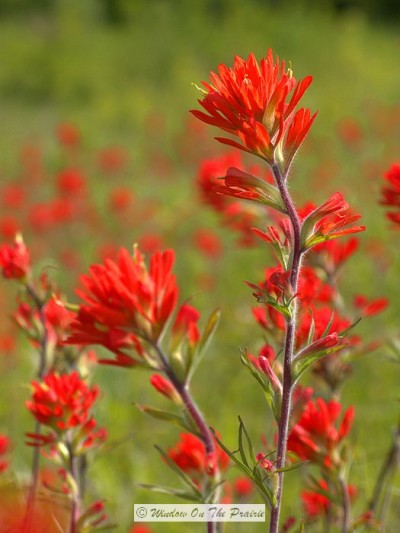

Young seedlings grow comparatively rapidly. Seeds emerge more uniformly and quickly following an 8-week stratification period. Difficult or impossible to propagate from cuttings. Survival after transplanting to the garden is dependent on presence of a host whose roots form a solid root ball. Plants grow at a fast pace after transplanting and can easily be brought to bloom in pots. Soon thereafter, plants must be paired in pots with an appropriate host species. Transplanting: Wholeleaf paintbrush can be seeded in flats and germinated in the absence of a host species. Moisture management decisions should also account for the needs of the host species. Moisture Tolerance: Adapted to relatively dry conditions and requires some supplemental irrigation only in locations where summer moisture is infrequent. Soil: Adapted to a range of soil types and conditions, including alkaline soils, but requires well-drained conditions. This species commonly grows at elevations ranging from 3,000 to 8,500 feet. Often found within a wide range of plant communities, including woodlands, mesas, grassy plains, dry prairies, and slopes typically on gravelly or rocky soil. Native Habitat: Castilleja integra is native to the high plains and foothills of Arizona, New Mexico, Colorado, and Texas. To satisfy the hemiparasitic nature of wholeleaf paintbrush, as well as maintain the aesthetic value of the garden, a plant species with good host traits and with complimentary size and color should be chosen as a propagation companion. Wholeleaf paintbrush can be used in xeric beds or borders. Plants are herbaceous, dying back to below the ground each fall and sprouting underground crowns each spring. Mature plants are about 12 to 15 inches tall and produce up to a dozen flowering stems. The intense color exhibited by wholeleaf paintbrush is dominating and the plants are best used to intentionally draw the eye to a specific part of the garden. Flowers of wholeleaf paintbrush are brilliant orange-red and bloom over a significant period of late spring and summer, typically from May into July. Wholeleaf paintbrush adapts more easily to cultivation than most other species from this genus, meaning that with the use of proper techniques, it can be cultivated and marketed as a horticultural product. Appropriate host plants are essential for maintaining health and ultimately for survival of paintbrush growing in either pots or the garden. The key reason for minimal use in gardens is production barriers caused by the hemiparasitic (partially parasitic) nature of this genus. Uncommon in cultivated gardens, species in the Indian paintbrush genus are worthy of greater attention from the landscape industry. Most are parasitic on the roots of other plants such as sagebrush upon which they rely for essential nutrients.Scientfic Name: Castilleja integra Common Name: Wholeleaf Paintbrush, Wholeleaf Indian Paintbrushĭescription: Wholeleaf paintbrush is one of the universally recognized and adored wildflowers of the southwestern U.S. There are over 50 species which vary greatly in color and size, from four inches to 16 inches tall. Clinical studies have shown that the combination of nutrients found in paintbrush can shrink cancerous tumors.
#Indian paintbrush flower facts skin
In the Crow tradition these plants were crushed and put into open wounds or on any skin condition to promote healing. These plants are slightly sweet when in bloom and a good source of the essential nutrients selenium, vitamin C (ascorbic acid), and bioflavonoid (carotenoids), necessary for vitamins to function in the body and strengthening for the heart and circulatory system. The top half of the plant is collected as a food, eaten fresh as a salad green or cooked. The large bracts are where most of the nutrition and medicinal properties are found. The brightly colored parts are called bracts, which surround the flower but are neither flowers nor leaves. The colorful parts of these plants are often thought of as flowers, but they are not! The flowers are tiny. Although most are red on top, some are yellow or orange.

Indian paintbrush is the state flower of Wyoming.


 0 kommentar(er)
0 kommentar(er)
